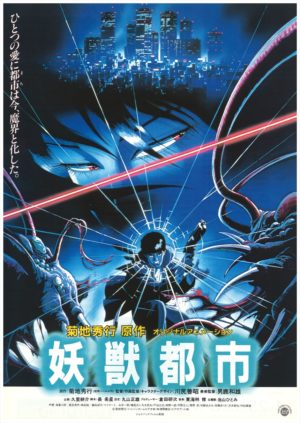 A seminal anime feature, notable for its one-of-a-kind mix of sex and mutation, compelling NIGHT WATCH-like narrative and myriad of impossible-to-forget images. 1987’s WICKED CITY (YOJU TOSHI) was an early effort by anime specialist Yoshiaki Kawajiri (preceded by the LENSMAN series and followed by NINJA SCROLL, VAMPIRE HUNTER D: BLOODLUST and X). It was based on a series of novels by VAMPIRE HUNTER D creator Hideyuki Kikuchi (the first three of which are available in English language editions courtesy of Tor/Seven Seas), and inspired a 1992 Hong Kong-made live action version from producer Tsui Hark.
A seminal anime feature, notable for its one-of-a-kind mix of sex and mutation, compelling NIGHT WATCH-like narrative and myriad of impossible-to-forget images. 1987’s WICKED CITY (YOJU TOSHI) was an early effort by anime specialist Yoshiaki Kawajiri (preceded by the LENSMAN series and followed by NINJA SCROLL, VAMPIRE HUNTER D: BLOODLUST and X). It was based on a series of novels by VAMPIRE HUNTER D creator Hideyuki Kikuchi (the first three of which are available in English language editions courtesy of Tor/Seven Seas), and inspired a 1992 Hong Kong-made live action version from producer Tsui Hark.
An English dub of WICKED CITY was put together by anime dubbing maestro Carl Macek, but you’re advised to view it in its original and preferred Japanese language version.
Renzaburo Taki is a playboy who works in the sales department of a Tokyo-based electronics company. This is his “official” job, but in actuality Taki is part of the Black Guard, whose job is to guard our world from demons residing in a parallel dimension. A pact between the two worlds has ensured an uneasy peace for thousands of years, and a renegotiation of the treaty is about to occur.
After picking up a woman one night only to discover that she’s a demon in disguise, complete with spider legs and a fanged vagina, Taki is paired with Makie, a seductive Black Guard who happens to be a demon. Makie proves her allegiance by killing some fellow demons who attack Taki on the night of their first meeting.
The two are charged with protecting Guiseppe Mayart, a seriously annoying 200-year-old midget who the demons (understandably) want to kill. Taki and Makie move Mayart into a hotel with a force field around it powerful enough to keep out demons—allegedly, anyway! On the very night they move into the place an old demon flame of Maki’s infiltrates the hotel. The demon is killed, but not before Mayart escapes from the hotel and into the arms of a demon ho that nearly kills him.
Taki and Makie rescue the lech, and are pursued by demons for their trouble. Makie sacrifices herself to save the two men, winding up the sexual plaything of several horny demons. Taki saves her, which entails all manner of mutation and insanity at the hands (and other appendages) of the demons, and winds up in the sights of the spider woman who bedded him early on. This bitch shoots webbing from her vagina and seems poised to take down our heroes—but then some unseen supernatural force takes the spider skank out. Apparently this higher power is using Taki and Makie for a much greater purpose: to begat a demon-human hybrid that will take over the world!
This film has problems, mainly some wildly erratic pacing: the opening scenes are positively breathless in their kinetic mix of violent action, sex and exposition, and certain portions of the rest of the film have a similar vibe. What it lacks is a cohesive narrative, being fragmentary and episodic. This is probably due to the fact that director Yoshiaki Kawajiri was initially contracted to deliver a 35-minute film (back in ‘87 anime features were something of a rarity) that was later padded out to 82 minutes.
Of course it’s the film’s extraordinary imagery that resonates. The mind-scraping depictions of melting breasts, torsos opening into giant vaginas, fists smashing through skulls, carnivorous shadows and human limbs mutating into hideous spider legs are amazing sights, not unlike the best parts of John Carpenter’s THE THING and VIDEODROME packed into a sexy sci fi actioner. The old school animation isn’t even bad, with well-integrated movement and good use of fixed focus. The film’s sex-and-gore mix was certainly nothing new in anime, even in 1987 (see the notorious UROTSUKIDOJI flicks, the first of which appeared the same year as this film), yet the not-inconsiderable skill and feverish imagination that inform WICKED CITY are undeniable.
Vital Statistics
WICKED CITY (YOJU TOSHI)
Japan Home Video Co.
Director: Yoshiaki Kawajiri (and Carl Macek)
Producers: Kenji Kurata, Makoto Seya
Screenplay: Kisei Choo
(Based on the novels by Hideyuki Kikuchi)
Cinematography: Kinichi Ishikawa
Editing: Harutoshi Ogata
Cast (English language version): Gregory Snegoff, Mike Reynolds, Alexandra Kenworthy, Ronald Baker, Philip Goug, Tammy Halloway, Lias Robinson
